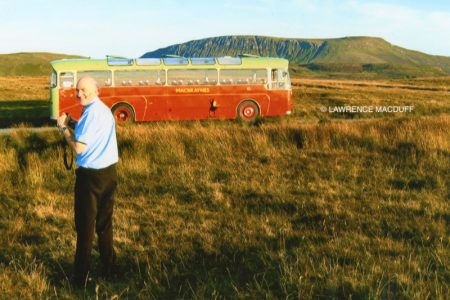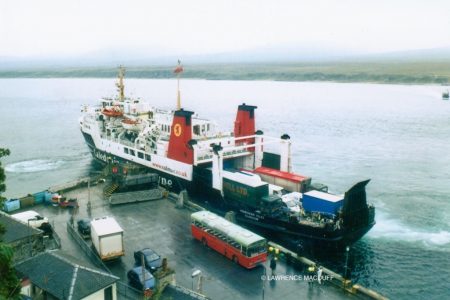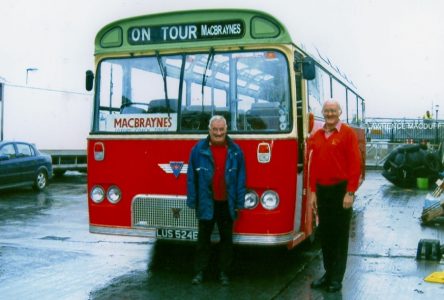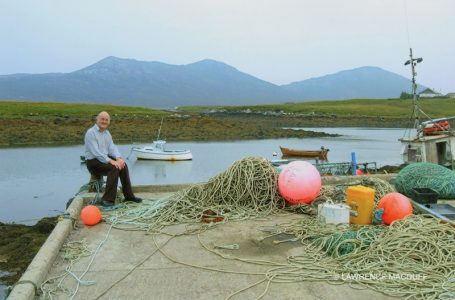
Lawrence on the road: his vintage MacBrayne bus has been admired throughout the highlands and islands, as well as Shetland, Orkney and the Mod. In 2005 he and his partner Sarah used it as a substitute camper van for their Hebridean holiday
Lawrence Macduff is equally renowned for ship photography and for his exploits with a lovingly preserved MacBrayne bus. Here he combines the two in an epic traversal of Hebridean land and sea.
When I first read Stuart Craig’s book Away with the Ferries, I recognised the sort of leanings that are deeply buried in the psyche of many of us steamer enthusiasts. We often have a set idea of where we wish to travel, what images we want to capture for posterity, and how we are going to get them. But we also have that desire just to be on board, to sample the shipboard experience with its particular smells and sounds, enjoy the catering, and marvel at the many and diverse views from the decks of the ship.

While in North Uist in 2005, Lawrence took advantage of the opportunity to harvest some peat (with permission) on the moor between Clachan and Lochmaddy. His bus, LUS 524E, was one of two new 49-seaters ordered by MacBraynes in 1967-68 for the Glasgow-Tarbert-Campbeltown route. The company’s usual supplier, the London based firm AEC (builders of London’s famous red buses), built the mechanical parts, and coach builder Willowbrook constructed the bodywork. Lawrence says the coach suffered from very poor saloon ventilation – passengers were regularly travel sick – and it was removed from the route after six months. In 1970 all MacBrayne buses were taken over by Highland Omnibuses, who kept this one in service until 1981. It was then sold to Belfast-based preservationists, from whom Lawrence and the late Robert Grieves bought it in 1990. It was fully refurbished in 1994 and has remained in active use ever since. ‘It still drives very well,’ says Lawrence. ‘It was never modified, so in fine weather it is still too warm for travellers inside!’
Then there is the legend that is the story of shipping services within the Clyde and across the western seaboard. Its background is long, convoluted and often fascinating. As all steamer buffs know, MacBraynes was once that diverse lifeline service provider, with responsibility for the provision, co-ordination and operation of all three of its branches of operation. First came the steamers – from 1851 onwards. Then as ‘technologies’ developed from the early years of the 20th century, the introduction of buses in 1906 permitted the substitution of some sailings while providing fractionally more comfortable connections with other routes. Finally, road freight services commenced in 1920 when the company’s first lorries took to the road, permitting a further re-shaping of cargo sailings. These revisions were all aimed at achieving further economies in operations. Then, in 1969-70, all road services were disposed of. Thereafter ferry services began to evolve towards the pattern we see today.
My interests in sea and road transport developed alongside each other, but when my fascination with red funnels took root, this transcended all else in my teenage affections, and it was only later that road transport caught up. In 1990 I was given the opportunity to acquire a MacBraynes 49-seat bus in co-ownership with the late Robert Grieves, MacBraynes driver and author. At the time we bought the bus, I was still in banking — and while I had lots of interest in buses, I did not possess a bus licence. There was nowhere to keep such a brute. I had little mechanical knowledge and no bottomless pit from which restore, run and repair such a major liability.
Turn the clock forward 15 years, to 2005. I had been out of the increasingly disreputable financial services industry for five years, and within that period had amassed some useful bus driving experience. My twin passions for ferries and the western seaboard of Scotland remained as strong as ever, and above all else I now had the support and encouragement of Sarah, my partner. Some years earlier I had been recounting to a friend how I had given my then new lady friend a scenic drive round Aberdeen in my MacBraynes bus. He retorted that he’d heard of cars being used for ‘bird pulling’ purposes, but never a bus!

Lawrence’s distinctive MacBrayne bus on Port Askaig pier next to Hebridean Isles, on which — thanks to Captain Norman Martin — he had a bridge visit during the voyage to Oban via Colonsay. It was a ‘thoroughly enjoyable’ voyage, despite the poor weather, and the next night was spent peacefully at Oban’s coach park
By 2005, I had taken the bus back to many of its former routes and also taken pictures of it alongside a couple of CalMac ferries. The idea then germinated in my mind that the way to do some more extensive ship and bus camerawork was to undertake a trip to the Hebrides with it. It needed to be late-season to be sure of space (and thank goodness I wasn’t contemplating this operation today) but the biggest headache would be finding accommodation. Then, we thought, maybe we could gain more flexibility by simply camping on board the bus: it couldn’t be any worse than doing it with the car.
That verdict was based on hard experience. Back in July 1998, Sarah and I had gone on a camping holiday in the Outer Hebrides. She had camping experience. I didn’t — and my first time in a tent turned into a baptism of fire on a never-to-be-forgotten night in the South Uist wilderness. The weather had deteriorated savagely, and trying to erect a tent in the face of a stout sou’wester at 11pm was a battle we don’t plan to attempt again!
No such bother for our 2005 mission. All we had to do was stack our camping gear on the bus. I had made Dunoon its base, so it was an easy journey to Kennacraig to join Isle of Arran and enjoy the passage to Port Askaig. Even at this stage, the bus attracted attention. There were the usual questions: why were we here, where were we going, did we offer tours? Oh to say ‘yes’ to the latter and make a mint!
First job at Port Askaig was to get the bus reversed alongside the ‘Arran’, our first ferry of the tour, in order to photograph toe two together. In cases like this you’ve got to be so watchful of all the hardware lying about the pier, especially bollards which can easily be hidden from your rear view mirrors, with dire results if you strike one!

‘Before boarding at Port Askaig, I clocked another well kent face — that of former steward of the 1939 Lochiel, Archie Shaw’
But, no problem, I got the bus parked, then had a breath-extracting gallop up to the top of that ever so special vantage point that overlooks the pier, where you can’t fail to get a decent shot. But there are hidden traps, and I recall once catching my toe in a piece of fence-wire buried in the grass and ending up with cameras and gear flying everywhere, though fortunately not over the cliff face.
The weather was improving, so it was no hardship to take the bus down to Port Ellen, bag another bus/n/boat shot while ‘Heb Isles’ was still in port and then return to park out of harm’s way at Port Askaig pier. Here, we spent our first night in our contrived sleeping arrangements. It turned out, sadly, to be not the cleverest of choices. Next morning, Argyll & Bute Council’s Eilean Dhuira made an early crossing with all the attendant pier activity – clanking, banging, shouting, sounds of vehicle engines starting, so we just had to get up, to a right dreich morning at that.
I managed a second ‘double take’ of bus and ferry at Port Askaig, this time with ‘Heb Isles’ which would, under the command of the now retired and kenspeckle Captain Norman Martin, take us on to Oban via Colonsay. Having descended to ground level again, I clocked another well kent face — that of the former steward of the 1939 Lochiel, Archie Shaw. Many of you older members will remember Archie from the 1960s and 1970s: he stayed at the little croft just off the hairpin half way up the hill from the pier. Very kindly, having seen we were self catering, he brought down a dozen fresh eggs. It was great to have a catch-up before I joined the ferry queue and duly boarded ‘Heb Isles’. A thoroughly enjoyable passage followed, though sadly this was one of the few days when wet weather got a hold, so we saw little but were able to enjoy a bridge visit as well. An overnight up at Oban’s coach park was relatively peaceful and the next day dawned bright, the forerunner of many to follow.
With the bus safely on board Clansman (parked near the stern) for the voyage to Barra, many crew came across for a look at this piece of MacBrayne history. Some of them had not even been born when the bus entered service and were quite curious about this piece of company heritage. We headed up to the passenger accommodation and enjoyed all the beauties of the passage.
I had first travelled to Barra 38 years previously and, like many other CRSC members, have returned time and again, its appeal undiminished. We were blessed with fine weather for the whole voyage, and it was with keen anticipation that I prepared to take the bus ashore. We’d worked out a game plan, but it backfired as Sarah had not been able to get down the gangway in time to capture that all important snap of my bringing the bus onto Barra soil for the first time. For future shots, the crew were always happy to let Sarah come off the ship’s ramp instead, run like hell (not too hard for a former PE teacher) and be ready for my bringing the bus ashore where she’d get that never-to-be-repeated picture.
Now, while I was bringing the bus off the ramp, I was also looking further ahead to see where I could stop and claim a picture showing the coach in the foreground with Clansman pulling away from the berth. Lady luck was with me: I saw a spot that would do, even though modern facilities in Barra now mean you have lamp posts in your way. Then, fired up with the beauty of the night, I thought how nice it would be to go across to Vatersay, whose beaches are among the finest in the Outer Hebrides. The fact that a MacBrayne bus the size of mine had never visited this island was no disincentive: it had a population, so a bin lorry had to be able to get access too! All went well until I came round a bend and found a Range Rover and big trailer just 50 yards away. Panic — until, with wonderful island courtesy, the owner kindly reversed 75 yards to a place were we could pass, and waved heartily as we did. At this stage, I had still to realise what a door-opening passport it could be to have a MacBrayne bus.
After a peaceful night, the glorious morning that came next was capped by Archie Shaw’s Islay-bred eggs, which just couldn’t be bettered. Then we were off to explore Barra in our own tour bus. A gentle island circuit was followed by some basking in the sun at Ardmhor, where I cased the slipway to see what it looked like for our crossing to Eriskay the next morning on Loch Bhrusda. How facilities for tourists have improved: at the Ardmhor slipway there was now a new toilet and shower block with hot running water — an unheard of benefit even 10 years previously.
After returning to Castlebay to photograph Clansman’s evening arrival, we were up the next morning to do the same for Loch Bhrusda’s arrival at Ardmhor. This was to be my first slipway boarding of the holiday. As I had been across to Rhubodach on Loch Dunvegan and had taken the precaution of loading wooden ramps, I didn’t expect any problems.
Such is Loch Bhrusda’s sound signature, quite unique in the fleet, that we heard her leaving Eriskay! Boarding proved slightly tricky, with minimum clearance on her ramp and, rather disappointingly, little or no assistance from the crew. A brief scraping when coming off the Eriskay slipway did little damage. We then continued across that lovely island and over the stunning sand-surrounded causeway to Ludag in South Uist.
Here we spent a couple of days dodging about the Uists. South Uist in particular was a favourite for the late Jim Aikman Smith, who loved to potter about here in between periods of frenetic filming activity. It’s easy to see why the island appeals so much, with its mountain background to the east and the wide expanse of machair to the west, fringed by sandy beaches to die for.
We visited friends in Benbecula and Lochmaddy, and between times I set the bus up for pictures in readily identifiable scenic locations for my photographic archive. We were also gifted a couple of bags of peat by our friends in Lochmaddy, and with a bus-sized boot, had plenty of room to stow them for winter use in Dunoon.
Another peaceful night, this time at the slipway on Berneray, was followed by an early crossing on Loch Portain, whose ramps were that bit longer than the ‘Bhrusda’ and caused us no trouble. Sadly the weather was dull and windy, so we didn’t benefit from the stunning beauty of this crossing, one of the finest short sea passages in the Outer Hebrides. Forty years earlier, I joined Hebrides for my first trip between Tarbert and Lochmaddy, wondering at the time what a passage through the Sound of Harris would be like.
Here it was — now a reality which, together with the causeways on the road from Eriskay, has so transformed inter-island travel. After the ever-so-vocal crossing on the ‘Bhrusda’, conditions on Loch Portain were almost silent. We enjoyed an onboard cup of tea, having decided against the palaver of making breakfast so early. On arrival at a chilly 7am, Sarah duly went ashore with her camera, while I started the bus to prepare for going ashore.
Old diesels don’t like the cold, and I noticed with some trepidation that there was going to be an embarrassing amount of exhaust fumes, despite a featherlight touch on the accelerator as I inched down the ramp. As soon as I reached the slipway, and applied a fraction of throttle, clouds of smoke buried the poor crew member detailed to watch me clearing the ramp, while my better half tried to record the event without getting asphyxiated!

Disembarking at Leverburgh: ‘As soon as I applied a fraction of throttle, clouds of smoke buried the poor crew member’
A miserable day in Harris followed, together with an exceptionally wild wet night parked at the Hushinish road end, but by the time we reached Stornoway next afternoon, it was glorious once more. Isle of Lewis was the one fleet member on which we would not cross on this trip, but pictures of ship and bus together in Stornoway were a must.
Technical problems then reared their head. The terminal area is as flat as the proverbial pancake: there was nowhere to put the bus where the background view of the ship wasn’t obstructed by parked cars. Next day would bring a unique solution, but for the night we were invited to park up at the Caberfeidh Hotel, thanks to a local bus driver friend. Next morning we revelled in our first ‘professional’ breakfast for a week.
On hearing of my pictorial dilemma, ‘Shonny’ (one of my bus contacts) got permission to borrow a cherry picker belonging to the council. He brought it to the terminal and parked it in such a way that I was able to clamber into the cradle and elevate myself to a commanding height in time for the arrival of the ‘Lewis’.
Without a doubt this was a Jim Aikman Smith-type solution par excellence – he would have wholeheartedly approved! Sadly, the view was straight into the sun, which for one of the few times in my 40 years of taking ship pictures, I could have done without. It wasn’t the best shot, but it was a heck of a sight better than I had dared to hope for.
In the second and final episode of his ‘Mission Improbable’, Lawrence and Sarah return home via Skye, Mull and Iona.

At Castlebay, Lawrence recreates the old MacBrayne combination of coach and ferry, as Clansman leaves Barra for the return voyage to Oban
Published on 17 July 2020














